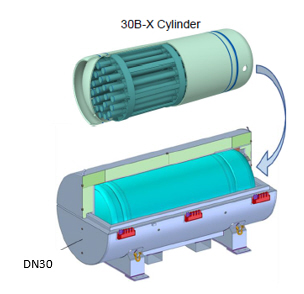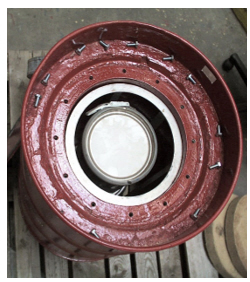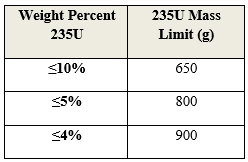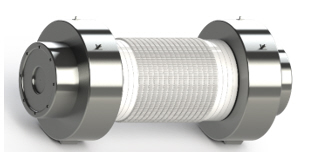HALEU Supply Chain: Transport Packages
AUTHOR
Nicolas Guibert
Jay Thomas
Orano TN
PRESENTED
March 13, 2024
Waste Management Symposia
ABSTRACT
This paper will explore the different high-assay low-enriched uranium (HALEU) fuel packages being developed by Orano TN. This paper will also discuss challenges that the industry will have to overcome implementing
a new supply chain for HALEU, including the development and management of large fleets of transport packages, the ramp up forecast for the different products, and the implementation of international physical protection requirements.
The
transport of radioactive material, and especially fissile material, has always been a key component of producing nuclear energy since it enables the entire fuel supply chain to operate in the United States and globally as it does today. This is also
true for the new advanced reactors and their need for HALEU fuel that will require an entirely new supply chain with new types of fuel products and different sources of material supply than what is in place today. Between the enrichment, deconversion,
and final fuel fabrication processes for these new reactors, fissile material transports will be needed and will sometimes require new equipment and a new approach.
While much of the capacity increase will be needed in the same range of
enrichment as current commercial fuels, new transport packages will also be needed for transporting higher enrichment levels and at a larger scale than what is being done today. For a number of years, the industry has been actively preparing for these
needs, as has Orano, by developing a consistent fleet of transport packages and securing approvals by national regulatory bodies. Orano has developed new packages and improved existing packages to fulfil the industry’s evolving needs and to
transport the new fuel products being developed.
- For enriched UF6, Orano developed the DN30-X, which is approved to transport HALEU UF6 in the United States. Also, samples can be shipped with the VP55 transport packages, also approved in the United States.
- For HALEU uranium products in different forms—such as UO2 or U3O8 powder, uranium metal, TRi-structural ISOtropic particle (TRISO) fuel—there are a couple of transport options, including the development of a fleet of VP55 packages, which
is already approved in the U.S. for HALEU transport and is in the process of being deployed internationally. The VP55 is designed to be robust, simple to handle, and easily scalable to industrial volumes.
- For the final fuel products, there are a large variety of designs, forms, and products available for fuel designers and fabricators. Most of the package developments will be focused on the new types of fuels that will have to be transported in very
large quantities to support the new and expanding reactor market.
- For the used fuels and radioactive waste, new transport and storage product lines will be needed to support the new reactors’ life cycle models.
While often underestimated, the transport packages are expected to be one of the pillars to make the large-scale HALEU deployment a success, at a fast pace, and safely. This is a requirement to achieve the new reactor developments and timely implementation
successful, too.
INTRODUCTION
The world’s nuclear energy industry is always evolving. The question of how to increase the power cycles of the current reactor fleet is under consideration, in particular in the United States. New reactor technologies such as Small Modular Reactors
(SMR) or Advanced Modular Reactors (AMR) to produce electricity are also being investigated. Both avenues will likely result in a need to increase the enrichment levels of uranium for the production of heat or electricity above the common level at
5%.
Increasing a reactor’s power cycle necessitates 235U enriched to between 5% to 10%, referred to as Low Enriched Uranium plus (LEU+). SMR or AMR design concepts require High Assay Low Enriched Uranium (HALEU) with 235U enriched up
to 19.75%. In 2020 NEI forecast the HALEU demand in 2030 for enrichment higher than 10% at 137 metric tons and ramping up to 501 tons in 2035.
The production of uranium with higher enrichments will require the ability to transport this
uranium in its various forms throughout the fuel cycle. This paper will present the existing solutions for each material form, describe the current activities in progress to meet these new needs, and outline the possible ways to optimize the current
solutions.
ENRICHED UF6 TRANSPORTATION
The majority of the enriched UF6 transported today is enriched to less than 5% and transported in 30B cylinders inside protective overpacks. These packages are licensed for this material based on a safety analysis that assumes water exclusion. Above 5%
enrichment, the regulations require that criticality analyses consider flooding of the content.
Orano is currently working on two solutions for the transport of UF6 with enrichments of up to 19.75%.
Development of the DN30-X
To meet current regulations, Orano has developed a new package, the DN30-X, which consists of the existing DN30 Protective Structural Packaging (PSP) and a new cylinder, the 30B-X. The 30B-X cylinder is based on the 30B cylinder design to
which is added a Criticality Control System (CCS) (see Figure 1).
 Figure 1. The DN30-X
Figure 1. The DN30-XThe outer shell, valves, and plug of the 30B-X are identical to those of a 30B cylinder.
The CCS is inserted inside the cylinder with control rods filled with neutron poison. The CCS maintains a CSI = 0 for transport.
Two designs
are possible, DN30-10 and DN30-20, for optimized UF6 capacity according to the enrichment to be transported.

The difference between DN30-10 and DN30-20 is the number of rods inside the CCS.
The U.S. NRC licensed the DN30-X in March 2023. Licensing in France is in progress and is expected in the second semester of 2024. Validations in other countries
will follow upon request.
In parallel to licensing in France, two prototypes of the DN30-10 have been delivered to two enrichment facilities for testing to integrate the cylinders into their plant processes.
Use of the existing 30B cylinder
The
second solution for transport involves evaluating the standard 30B cylinder with consideration for water flooding. The preliminary studies are underway through a voucher granted to Orano by the DOE Office of Nuclear Energy’s Gateway for Accelerated
Innovation in Nuclear (GAIN) program. Under this voucher, Orano collaborates with Oak Ridge National Lab (ORNL) and provides technical support.
ORNL will review previous studies of UF6 cylinders and extend such studies to establish best
estimates of physical and chemical configurations for a 30B cylinder with water flooding. ORNL will use these best estimates of physical and chemical configurations as input to baseline criticality analysis cases. The criticality studies will consider
and evaluate selected bounding transportation safety cases for individual packaging in isolation and package arrays.
The conclusions of this study will be used by Orano to evaluate nuclear criticality for the DN-30 package. These evaluations
may be used to define limits on the number of UF6 packages that can be transported in a conveyance and consignment without using the moderation exception rule in 10 CFR 71.55(g) or SSR-6 para. 680 that limits enrichment to 5%.
If the results
are favorable, Orano plans to submit applications for revised certificates to transport the higher enrichments using 30B cylinders. This work may also lead to an application for LEU+ enrichment levels up to 10%.
ORNL plans to issue its
reports later in 2024. With favorable results, the licenses may be revised by the end of 2025.
URANIUM OXIDES, METALS, AND ALLOYS
Multiple transport package options exist today for uranium oxides, metals, and alloys, some of which can transport enrichments of 235U as high as 100%. The choice of packaging depends on the logistics flow and quantity per transport.
Versa-Pac
The
Versa-Pac is a certified (in UK as well) Type A fissile packaging (USA NRC Certificate # USA/9342/AF-96) available in two drum sizes: 55 gallons (VP-55, see Figure 2) or 110 gallons (VP-110). The Versa-Pac is licensed for the following contents (also
licensed for uranium hexafluoride in 1S and 2S cylinders):
- Uranium oxides
- Uranyl nitrate crystals
- Uranyl fluorides and carbonates
- Uranium metal and alloys
- Natural thorium
- TRISO fuel and compact

Figure 2. VP-55 with High-Capacity Basket Configuration
The contents can be transported using inner containers with a number of configurations:
- Single or dual 5-inch pipe containers
- High-capacity baskets incorporating neutron moderators to accommodate the highest amounts of high enrichment material
- Three stackable 3-gallon containers
- Poly bottles
The maximum allowable quantities depend on the material, the enrichment level, mode of transport, and the presence of hydrogenous material. Inserts and baskets of various sorts can be used to increase the payload capacity. Table 2, below, illustrates
the authorized quantities of various forms that can be optimally and economically used to support future LEU+ and HALEU transportation and storage.
The dimensions (Outer / Cavity) of the Versa-Pac models are as follows:

Up to 48 VP-55s can be loaded into an ISO 20-foot container for a total payload, for example, of up to 2,880 kg of UO2 powder from 235U enriched at 20%.
BU-D
Licensed in several countries, BU-D packaging is used worldwide.
The authorized content is uranium oxide.
For uranium enriched up to 5%, uranium can be present in addition to uranium oxide in the following chemical forms:
- Ammoniumdiuranat (ADU)
- Uranylnitrat solid (UNH)
- Ammoniumuranylcarbonat (AUC)
- Uraniumtetrafluoride (UF4)
- Sodiumuranate
For uranium enriched between 5% and 10%, uranium may be present only as uranium oxide and in powder form.

Figure 3: The BU-D packaging
The BU-D packaging (see Figure 3) consists of an outer 213-liter drum and an inner 65-liter drum, both made of mild steel. The space between inner and outer drum is filled with lightweight concrete.
The outer drum is closed by a lid with a clamping ring and EPDM gasket, the inner drum is closed by a bolted lid and also with an EPDM gasket. The outer and inner surfaces are coated with a two-component epoxy paint.
The inner container may hold up to three stainless steel pails containing the uranium materials. The inner diameter of the pails is a maximum of 285 mm. The exterior dimensions are: 608 mm D x 890 mm H.
The content mass is limited to 90 kg with maximum 235U mass limits as shown in Table 3 below:

Up to 70 BU-Ds can be loaded into an ISO 20-foot container for a payload up to 45.5 kg of 235U enriched to 10%.
Perspectives
Despite the packagings listed above being authorized for enrichments up to 20%, some of these packages commonly used today may not be of sufficient capacity to meet the industry’s projected quantities for LEU+ and HALEU. Based on the expected quantity of material needed to be transported on a recurrent basis, it is worth considering the development of a new packaging design for higher enrichments, increased capacity to optimize the number of packages and shipments and building a sufficiently sized fleet of packages to support the forecasted quantities of LEU+ and HALEU material.
USED FUELS
For commercial used nuclear fuel in oxide form, no solution yet exists, as the current packages are only licensed for a maximum of 5% enrichment.
Figure 4. The TN Eagle transport package
One option to optimize the cost is to adapt existing packaging to the new types of fuel. Among the current packages, the Orano TN Eagle modular concept can be adapted to required dimensions (see Figure 5). Its simplified design reduces manufacturing lead time while ensuring the highest levels of safety and robustness.
The TN Eagle has already been licensed in France and in the United States by the NRC for the transport of current used fuel assemblies.
CONCLUSION
To transport and store materials needed to produce oxide fuel, packages already exist to meet the projected HALEU demands, at least for the ramp up and development of SMR reactors. The development of new packages may help optimize transportation and support transporting greater quantities of these materials at the same time.For other types of materials such as metallic fuel or molten salt for AMR designs, existing packaging will be evaluated for compatibility with these fuel types. The need for new development may arise at this time.
Orano is already working on several global transport solutions for SMR and AMR projects, and can provide experience and knowledge in packaging and transport to help customers optimize their transport costs.
Anticipating and developing packaging solutions is key to optimized transport scenarios and should be integrated early in the reactor design phase.
>> Return to Orano White Papers
